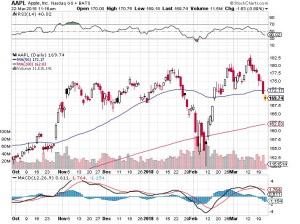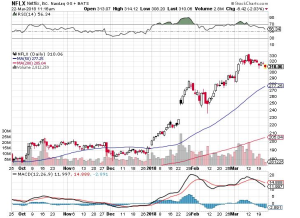Finding A New FANG
We all love our FANGS.
Not only have Facebook (FB ), Apple (AAPL ), Netflix (NFLX) and Alphabet (GOOGL) been at the core of our investment performance for the past nine years. We also gobble up their products and services like kids eating their candy stash the day after Halloween.
All four of the FANGs are now in a race to become the first $1 trillion company in history. My bet is on Amazon, but then again, all four will eventually do it.
In fact, the FANGs are so popular that we need more of them, a lot more. So how do we find a new FANG?
Here is where it gets complicated. None of the four have perfect business models. All excel in many things but are deficient at others.
So, there are at least four different answers as to what makes a FANG. A more accurate answer would probably be 4 squared or four to the 10th power.
I will list the eight crucial elements that make a FANG.
1) Product Differentiation
In medieval times, location was the most important determinant of business success. If you owned Ye Olde Shoppe at the foot of London Bridge you prospered.
Then great distribution was crucial. This occurred during the 19th century when the railroads ran the economy.
Products followed with the automobile boom of the 20th century when those who dreamed up 18-inch tail fins dominated. This strategy was applied to all consumer products.
The Financial age came next when cheap money was used to assemble massive conglomerates, which was the primary determinant of success.
The 80s and 90s spawned the era of global brands, be it Coca-Cola, MacDonald’s, Lexus or Gucci.
Today, the global economy is ruled by those who can provide the best services. Facebook offers you personal access to a network or 1.5 billion. Apple will sell you a phone that can perform a magical array of tricks.
Netflix will stream any video content imaginable with lightning speed. Alphabet will deliver you any piece of information you want as fast as you can type, but charges advertisers hundreds of billions of dollars to get in your way.
This has created what I call an “Apple” effect. It stampedes buyers to pay the highest premiums for the best products, assuring global dominance.
While Apple accounts for less than 10% of the smartphone market, it captures a stunning 92% of the net profits. Everyone else is just an “also-ran.”
Instead of driving my car into a dingy dealership every few months to get ripped off for a tune-up, Tesla (TSLA ) does it remotely, online, while I sleep, for free.
Unlike battling for a smelly New York taxi cab in a snowstorm, a smiling Uber driver will show up instantly, know where to go, automatically bill me at a discount price, and even give me restaurant recommendations in Kabul.
And you all know what Amazon can do. It beats the hell out of looking for a parking space at a mall these days, only to be told they don’t have your size (48 XLT).
2. Visionary Capital
If you have a great vision you can get unlimited financing for free from investors anywhere. That puts those who must pay for expensive external financing for growth at a huge disadvantage.
Have a great vision, and the world is your oyster.
Elon Musk figured this out early with Tesla. By promising a “carbon-free economy” he has been able to raise hundreds of billions of equity capital even though his firm has never made a real profit.
Alphabet is “organizing the worlds information,” while Facebook is “connecting the world.”
Chinese Internet giant Alibaba (BABA) invented a holiday from scratch, “Singles Day,” November 11, which has quickly become the most feverish shopping day in history. In 2017, they booked an unbelievable $17 billion in sales in a single 24-hour period.
And you know the great thing about visions? Not only do venture capitalists and consumers love them, so do stock investors.
3) Global Reach
You have to go global or be gone. A company with 7 billion customers will beat one with only 330 million all day long.
Go global, and economies of scale kick in enormously. This is only possible if you digitize everything from the point of sale to the senior management. Some two-thirds of Facebook’s users are outside the US, although half its profits are homegrown.
By the way, the Mad Hedge Fund Trader is global, with readers in 135 countries. Our marginal cost of production is zero, and the entire firm is run off my American Express card. It’s a great business model.
4) Likability
Who doesn’t like Mark Zuckerberg, with his ever-present hoodies, skinny jeans, and self-effacing demeanor? And who did Facebook send to Washington to testify about internet regulation? The razor-sharp and witty Sheryl Sandberg, COO of Facebook, that’s who. The senators ate out of her hand.
Bill Gates and Steve Ballmer? Not so likable. Their arrogance invited a 10-year antitrust suit against Microsoft (MSFT) from the Justice Department.
And here’s the thing. If people like you, so will consumers, regulators and, yes, even equity investors. It makes a big difference to the bottom line and your investment performance.
5) Vertical Integration
Crucial to the success of the FANGs is their complete control of the customer experience through vertical integration.
When FANGs don’t manufacture their own products, as Apple does, they source them, rebrand them, and sell them as their own, as does Amazon.
The return on investment for advertising is plummeting. Just ask the National Football League. So it has become essential for companies to keep a death grip on the customer the second they enter your site.
Some, like Amazon again, will keep chasing you long after you have left their sites with special offers and alternative products. Even if you change computers, they will hunt you down.
This was the genius of the Apple store network. Buy one Apple product and they own you for life, like an indentured servant. They all integrate and talk to each other -– a huge advantage for a small business owner. And they are cool.
No pimple-faced geeks wearing horn-rimmed glasses here. Get your iPhone fixed and you don’t talk to a technician, but instead, you speak with a genius. It’s all about control.
Expect other strong brands to open their own store chains soon.
6) Artificial Intelligence
There is probably no more commonly known but least understood term in technology today. It’s like counting the number of people who have finished Stephen Hawking’s “A Brief History of Time” (I have).
A trillion-dollar company absolutely must be able to learn from the human data input and then use algorithms to analyze it. Data has become the oxygen of the modern economy.
The company then use other algorithms to predict what you’re most likely to buy next and then thrust it in front of your face screaming at the top of its lungs.
This has been evolving for decades.
First, there was demographic targeting. White suburban middle-class guys have all got to like Budweiser, right?
This turned into social targeting. If two friends “liked” the same brand, regardless of their demographics, they should be targeted by the same advertisers.
Now we live in the age of behavioral targeting. There is no better predictor of future purchases than current activities. So, if I buy a plane ticket to Paris, offerings of Paris guidebooks, tours, French cookbooks, and even sellers of black berets suddenly start coming out of the woodwork.
It would be a vast understatement to say that behavioral targeting is the most successful marketing strategy ever invented. So, guess what? We’re going to get a lot more of it.
As depressing as this may sound, the No. 1 goal of almost all new technological advancements these days is to get you to buy more stuff.
Better to use the public computer at the library to buy your copy of “50 Shades of Grey.”
7) Accelerant
If you want to throw gasoline on the growth of a company, you absolutely have to have the best people to do it. The companies with the smartest staffs can suck in free capital, invent faster, develop speedier services, and always be ahead of the curve when compared to the competition.
I’ll never forget the first day I walked onto the trading floor at Morgan Stanley (MS). I am 6’4” and am used to towering over those around me. But at Morgan, almost all the salesmen were my height or a few inches shorter.
The company specifically selected these people because they delivered better sales records. Height is intimidating, especially to customers.
And that’s what the FANGs have: the programming equivalent of an all 6’4” sales team.
A few years ago my son got a job as the head of International SEO at Google. He was rare in that he spoke fluent Japanese and carried three passports: US, British, and Japanese (born in London with a Japanese mom).
However, when he met his team, they all spoke multiple languages, were binational, and they were valedictorians, National Merit Scholars and Eagle Scouts to boot!
This is why immigration is such a hot-button issue in Silicon Valley. If one can’t get a work visa for a graduating Ph.D. in Computer Science from Stanford, that person can just go back to China or India to start a local competitor that may someday eat your lunch.
By the way, if you get a FANG on your resume, even for a short period, you are set for life. Oh, and by the way, Apple gets 100,000 resumes a month!
8) Geography
It’s all about location, location, location. It’s no accident that Silicon Valley took root near two world-class universities, the University of California, Berkeley (my alma mater), and Stanford across the bay.
Cal, in particular, was the recipient of massive government funding for the Manhattan Project that built the first atomic bomb during WWII. The tailwind lingers to this day.
Universities provide the raw materials essential to create hot-house local economies such as the San Francisco Bay Area. And as much as every region in the US or country in the world would like to do this, none have been able to do so.
There is only one place in the world were a company can hire 1,000 engineers from scratch, and that is the Bay Area.
Also, innovation is city-centered. Some two-thirds of future GDP growth will emanate from cities.
So, if you want to move your career forward, you better count on spending some serious time in Silicon Valley, New York, London, and Tokyo.
I’ve done all four.
So, there you have it. Now we know what makes a FANG. I’ll be addressing who the most likely FANG candidates are in a future letter.
I want to thank my friend, Scott Galloway, of New York University’s Stern School of Business, for some of the concepts in this piece. His book, “The Four” is a must-read for the serious tech investor.





So Where is the Next FANG?
The Diary of a Mad Hedge Fund Trader, published since 2008, has become the top performing trade mentoring and research service in the industry, averaging a 34.84% annual return for ...
more


